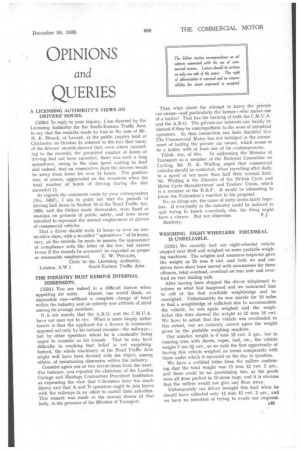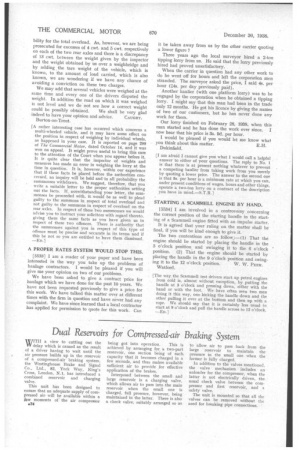OPINIONS
Page 43

Page 44

If you've noticed an error in this article please click here to report it so we can fix it.
and
UERIES
A LICENSING AUTHORITY'S VIEWS ON DRIVERS' HOURS.
[55301 In reply to your inquiry, I am directed by the Licensing Authority for the South-Eastern Traffic Area to say that the remarks made by him in the case of Mr. H. E. Bleach, of Lavant, at the public inquiry held at Chichester on October 31 referred to the fact that many of the drivers' records showed that, even where [according to the records) the permitted number of hours of driving had not been exceeded, there was such a long spreadover, owing to the time spent ,waiting to load and unload, that on consecutive days the drivers would be away from home for over 14 hours. The position was, of course, aggravated on the occasions when the total number of hours of driving during the day exceeded 11, AS regards the comments made by your correspondent (No. 5497), I am to point out that the periods of driving laid down in Section 19 of the Road Traffic Act, 1930, and the Orders made thereunder, were fixed as maxima on grounds of public safety, and were never intended to represent the normal employment of drivers of commercial vehicles.
That a driver should work 11 hours or over on consecutive days, with a so-called " spreadover "of 14 hours, may, on the records, be made to assume the appearance of compliance with the letter of the .law, but cannot (even if the records be accurate) be regarded as proper
• or reasonable employment. E. W. PHILLIPS.
. Clerk to the Licensing Authority, London, S.W.1. South-Eastern Traffic Area, THE INDUSTRY MUST REMOVE INTERNAL DISSENSION.
[55311 You are indeed in a difficult furrow when appealing for unity. Almost, one would think, an impossible one—without a complete change of heart within the industry and an entirely new attitude of mind among its average members.
It is not merely that the A.R.O. and the C.M.U.A. have not seen eye to eye. What is more deeply unfortunate is that the applicant for a licence is commonly opposed not only by his natural enemies—the railways— but by other operators whom he is constantly being urged to consider as his friends, That he may have difficulty in reaching that belief is not surprising. Indeed, the whole machinery of the Road Traffic Acts might well have been devised with the object, among others, of maintaining dissension within the industry.
Consider again one or two recent items from .the news. For instance, you reported the chairman of the London Cartage and Haulage Contractors Provident Institution as expressing the view that C-licensees have too much liberty and that A and B operators ought to join forces with the railways in an effort to curtail their activities. This remark was made at the annual dinner of that body, in the presence of the Minister of Transport.
Then what about the attempt to harry the private car owner—and particularly the farmer—who makes use of a trailer? That has the backing of both the C.M.U.A. and the A.R.O. The private-car interests can hardly be blamed if they be unsympathetic to the woes of industrial operators. In that connection one feels thankful that The Commercial Motor has not indulged in the amusement of baiting the private car owner, which seems to be a hobby with at least one of its contemporaries.
Think, too, of this. In addressing the Minister of Transport as a member of the National Committee on Cycling, Mr. H. R. Watling urged that commercial vehicles should be restricted, when travelling after dark, to a speed of not more than half their normal limit. Mr. Watling is the Director of the British Cycle and Motor Cycle Manufacturers' and Traders' Union, which is a member of the B.R.F. It would be interesting to know the Federation's reaction to his proposal.
No, as things are, the cause of unity seems fairly hopeless. If everybody in the industry could be induced to quit trying to knock everybody else, the thing might
have a chance. But not otherwise. F.J. Banbury.
WEIGHING EIGHT. WHEELERS PIECEMEAL IS UNRELIABLE.
15532] We recently had our eight-wheeled vehicle stopped near Hull and weighed on some portable weighing machines. The weights and measures inspector gave the weight as 23 tons 9 'cwt. and both we and our driver have since been served with summonses for three offences, total overload, overload on rear axle and overload on rear trailing axle.
After having been stopped the driver telephoned to • inform us what had happened and we instructed him to call at the first available weighbridge and be reweighed. Unfortunately he was unable for 70 miles to find a weighbridge of sufficient size to accommodate the vehicle, he was again weighed and the weighticket this time showed the weight as 22 tons 16 cwt, We have to admit that the vehicle was overloaded to this extent, but we certainly cannot agree the weight given by the portable weighing machine.
Our unladen weight is 6 tons 13 cwt. 2 qrs., but in running trim with sheets, ropes, fuel, etc., the vehicle weighs 7-ton alcwt., as we took the first opportunity of having this vehicle weighed on terms comparable with those under which it operated on the day in question.
We have a certified letter from the millers confirming that the total weight was 15 tons 12 cwt. 2 qrs., and there could be no questioning this, as the goods were all flour packed in 10-stone bags, and it is obvious that the millers would not give any flour away.
Unfortunately our driver brought this load when he should have collected only 14 tons 12 cwt. 2 qrs., and we have no intention of trying to evade our responsi bility for the total overload. As, however, we are being prosecuted for excesses of 4 cwt. and 5 cwt. respectively on each of the two rear axles and there is a discrepancy of 13 cwt. between the weight given by the inspector and the weight obtained by us over a weighbridge and by adding the tare weight of the vehicle, which is known, to the amount of load carried, which is also known, we are wondering if we have any chance of avoiding a conviction on these two charges.
We may add that several vehicles were weighed at the same time and every one of the drivers disputed the weight. In addition the road on which it was weighed is not level and we do not see how a correct weight could be possibly obtained. We shall be very glad
indeed to have your opinion and advice. CAUGHT. Burton-on-Trent.
[A rather interesting case has occurred which concerns a multi-wheeled vehicle, and it may have some effect on the position in respect of weighing by individual wheels, as happened in your case. It is reported on page 299 of The Commercial Motor, dated October 14, and it was won on appeal. It might prove useful to bring this case to the attention of the Court when you appear before it. It is quite clear that the inspector of weights and measures has made an error in weighing the lorry at the time in question. It is, however, within our experience that if these facts be placed before the authorities concerned, an inquiry will be held andin all probability the summonses withdrawn. We suggest, therefore, that you write a suitable letter to the proper authorities setting out the facts. If, notwithstanding your letter, the summonses be proceeded with, it would be as well to plead guilty to the summons in respect of total overload and not guilty to the summons in respect of overload on the rear axles. In respect of these two summonses we would advise you to instruct your solicitors with regard thereto, giving them the same facts as you have given us in respect of these two offences. There is authority that the summonses against you in respect of this type of offence must he precise and accurate in its terms and if this be not so you are entitled to have them dismissed.
—En . 1 •
A PROPER RATES SYSTEM WOULD STOP THIS.
[5533] I am a reader of your paper and have been interested in the way you take up the problems of haulage contractors. I would be pleased if you will give me your opinion on two of our problems.
We have been asked to give a contract price for haulage which we have done for the past 10 years. We have not been requested previously to give a price for this work. We have talked this matter over at different times with the firm in question and have never had any complaint. We have since learned that a local contractor has applied for permission to quote for this work. Can it be taken away from us by the other carrier quoting a lower figure ?
Three years ago the local surveyor hired a 2-ton tipping lorry from us. He said that the lorry previously hired had proved unsatisfactory.
When the carrier in question had any other work to do he went off for hours and left the corporation men stranded. The surveyor asked the price, I said 4s. per hour (24s. per day previously paid).
Another haulier (with one platform lorry) was to be engaged by the corporation when he obtained a tipping lorry. I might say that this man had been in the trade only 12 months. He got his licence by giving the names of two of our customers, but he has never done any work for them.
Our lorry finished on February 28, 1938, when this man started and he has done the work ever since. I now hear that his price is 3s. 9d. per hour.
I would he pleased if you would let me know what you think about this matter. E.H. Dukinfield.
[I am afraid I cannot give you what I would call a helpful answer to either of your questions. The reply to No. 1 is that there is at present nothing whatever to prevent a competing haulier from taking work from you merely by quoting a lower price. The answer to the second one is that 5s. per hour is a minimum rate at which you catt, under present conditions of wages, hours and other things, operate a two-ton lorry on a contract of the description you have in mind.—S.T.R.]
STARTING A SCAMMELL ENGINE BY HAND.
[5534] I am involved in a controversy concerning the correct position of the starting handle in the starting of a Scammell engine fitted with an impulse starter.
It is agreed that your ruling on the matter shall be final, if you will be kind enough to give it.
The two contentions are as follow.:—(1) That the engine should be started by placing the handle in the 3 o'clock position and swinging it to the 6 o'clock position. (2) That the engine should. be started by placing the handle in the 9 o'clock position and swing ing it to the 12 o'clock position. W. W. PEER. Watford.
[The way. the Scammell test drivers start up petrol engines from cold is, almost without exception, by putting the handle at 3 o'clock and pressing down, either with the hand or with the foot. We have often seen two men doing it this way, one kicking the handle down and the other pulling it over at the bottom and then up with a rope. We should say that it is certainly less usual to start at 9 o'clock and pull the handle across to 12 o'clock.
—ED.]












































































